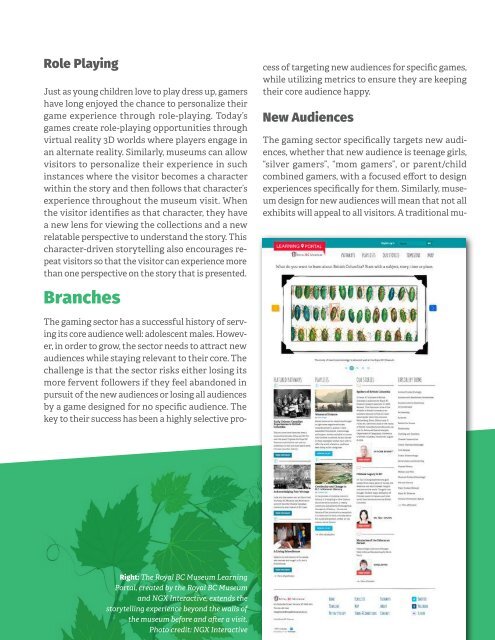Crossing Industries
2015-11-16-roundupIssue263-web-v14
2015-11-16-roundupIssue263-web-v14
Create successful ePaper yourself
Turn your PDF publications into a flip-book with our unique Google optimized e-Paper software.
Role Playing<br />
Just as young children love to play dress up, gamers<br />
have long enjoyed the chance to personalize their<br />
game experience through role-playing. Today’s<br />
games create role-playing opportunities through<br />
virtual reality 3D worlds where players engage in<br />
an alternate reality. Similarly, museums can allow<br />
visitors to personalize their experience in such<br />
instances where the visitor becomes a character<br />
within the story and then follows that character’s<br />
experience throughout the museum visit. When<br />
the visitor identifies as that character, they have<br />
a new lens for viewing the collections and a new<br />
relatable perspective to understand the story. This<br />
character-driven storytelling also encourages repeat<br />
visitors so that the visitor can experience more<br />
than one perspective on the story that is presented.<br />
Branches<br />
The gaming sector has a successful history of serving<br />
its core audience well: adolescent males. However,<br />
in order to grow, the sector needs to attract new<br />
audiences while staying relevant to their core. The<br />
challenge is that the sector risks either losing its<br />
more fervent followers if they feel abandoned in<br />
pursuit of the new audiences or losing all audiences<br />
by a game designed for no specific audience. The<br />
key to their success has been a highly selective process<br />
of targeting new audiences for specific games,<br />
while utilizing metrics to ensure they are keeping<br />
their core audience happy.<br />
New Audiences<br />
The gaming sector specifically targets new audiences,<br />
whether that new audience is teenage girls,<br />
“silver gamers”, “mom gamers”, or parent/child<br />
combined gamers, with a focused effort to design<br />
experiences specifically for them. Similarly, museum<br />
design for new audiences will mean that not all<br />
exhibits will appeal to all visitors. A traditional mu-<br />
Right: The Royal BC Museum Learning<br />
Portal, created by the Royal BC Museum<br />
and NGX Interactive, extends the<br />
storytelling experience beyond the walls of<br />
the museum before and after a visit.<br />
Photo credit: NGX Interactive


